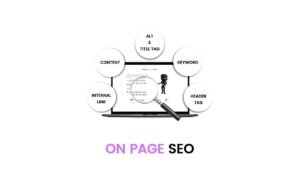In the world of digital marketing, analyzing website performance is essential for achieving online success. One crucial metric that marketers closely monitor is the bounce rate. A high bounce rate indicates that visitors are leaving your website after viewing only one page. It’s essential to understand what bounce rate is and explore effective strategies to improve its quality. In this blog post, we’ll delve into the concept of bounce rate, its significance, and actionable tips to enhance your website’s engagement and reduce bounce rate.
What is Bounce Rate?
Bounce rate refers to the percentage of visitors who leave your website after viewing a single page. These visitors neither explore other pages nor take any actions, such as making a purchase or submitting a form. Bounce rate is measured by dividing the number of single-page visits by the total number of entries to your website. It provides insights into the initial impression your website makes and indicates whether visitors find it engaging or relevant to their needs.
Understanding the Quality of Bounce Rate
While a high bounce rate may initially seem negative, it doesn’t always indicate poor website performance. In some cases, visitors may find exactly what they need on the landing page, leading to a quick exit. For example, if you have a contact page where visitors can find your phone number or email address, it’s expected that they will leave after retrieving the information.
However, a consistently high bounce rate across various pages suggests underlying issues with user experience or content relevance. It may imply that visitors are not finding what they’re looking for or encountering difficulties navigating your website. Hence, it’s crucial to improve the quality of the bounce rate to enhance user engagement and drive conversions.
Strategies to Improve Bounce Rate Quality
Here are Some Strategies to improve bounce rate quality:
Enhance Page Load Speed
Slow-loading pages frustrate visitors and drive them away. Optimize your website’s performance by compressing images, minifying CSS and JavaScript files, and leveraging caching techniques. A faster page load speed improves user experience, reduces bounce rate, and encourages visitors to explore more pages.
Provide Engaging and Relevant Content
Delivering high-quality, valuable content is vital for visitor engagement. Ensure your content is informative, well-structured, and matches users’ expectations. Use attention-grabbing headlines, compelling visuals, and clear calls to action to keep visitors on your site and encourage them to explore further.
Optimize Landing Pages
A high bounce rate on landing pages can indicate a mismatch between visitor expectations and the content they find. Optimize landing pages by aligning your ad copy or search keywords with the page content. Ensure that the landing page provides relevant information, is visually appealing, and guides visitors toward desired actions.
Improve Website Navigation
Complex or confusing website navigation can drive visitors away. Simplify your website’s structure and make it intuitive for users to find what they’re looking for. Implement clear and visible menus, a search bar, and breadcrumbs to help users navigate smoothly and reduce frustration.
Enhance Mobile Responsiveness
With the increasing use of mobile devices, having a responsive website design is crucial. A mobile-friendly site ensures that your content is accessible and visually appealing across different screen sizes. By providing a seamless mobile experience, you can engage mobile users effectively and reduce the likelihood of them bouncing.
Optimize Call-to-Action (CTA) Placement
A well-placed and compelling CTA can encourage visitors to explore more pages or take desired actions. Ensure that your CTAs are strategically positioned, visually appealing, and clearly convey the value proposition. Experiment with different placements, colors, and wording to find the most effective combinations.
Improve Page Formatting
Enhance readability by using clear headings, bullet points, and shorter paragraphs. Make use of white space to improve visual appeal and reduce cognitive load. Easy-to-read and well-formatted pages make it more likely for visitors to stay engaged and explore additional content.
Implement Internal Linking
Internal links guide visitors to related content on your website, encouraging them to explore further. Integrate relevant internal links within your content, directing users to related articles, product pages, or resources. This strategy not only reduces bounce rate but also boosts SEO by improving site structure and distributing link equity.
Use A/B Testing
Conduct A/B tests to compare different versions of your landing pages, headlines, CTAs, and other elements. This allows you to identify what resonates best with your audience and make data-driven decisions to improve engagement and reduce bounce rate.
Optimize Meta Descriptions
Meta descriptions appear in search engine results and play a significant role in attracting visitors to your website. Craft compelling and relevant meta descriptions that accurately reflect the content on your page. By setting clear expectations, you can entice users to click through and explore your site.
Understanding and improving bounce rates is a crucial aspect of optimizing website performance. By implementing the strategies outlined in this blog post, you can enhance user engagement, reduce bounce rate, and improve the overall quality of your website. Remember to regularly analyze your bounce rate, monitor user behavior, and adapt your strategies to meet the changing needs of your visitors. With a user-focused approach and continuous improvement, you can create a more engaging online experience and drive conversions to your website.








